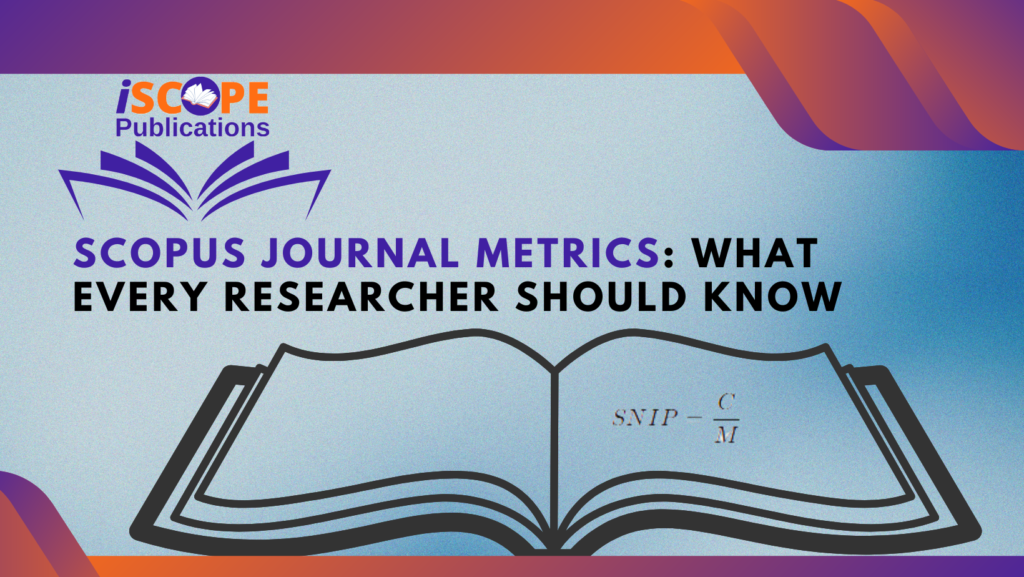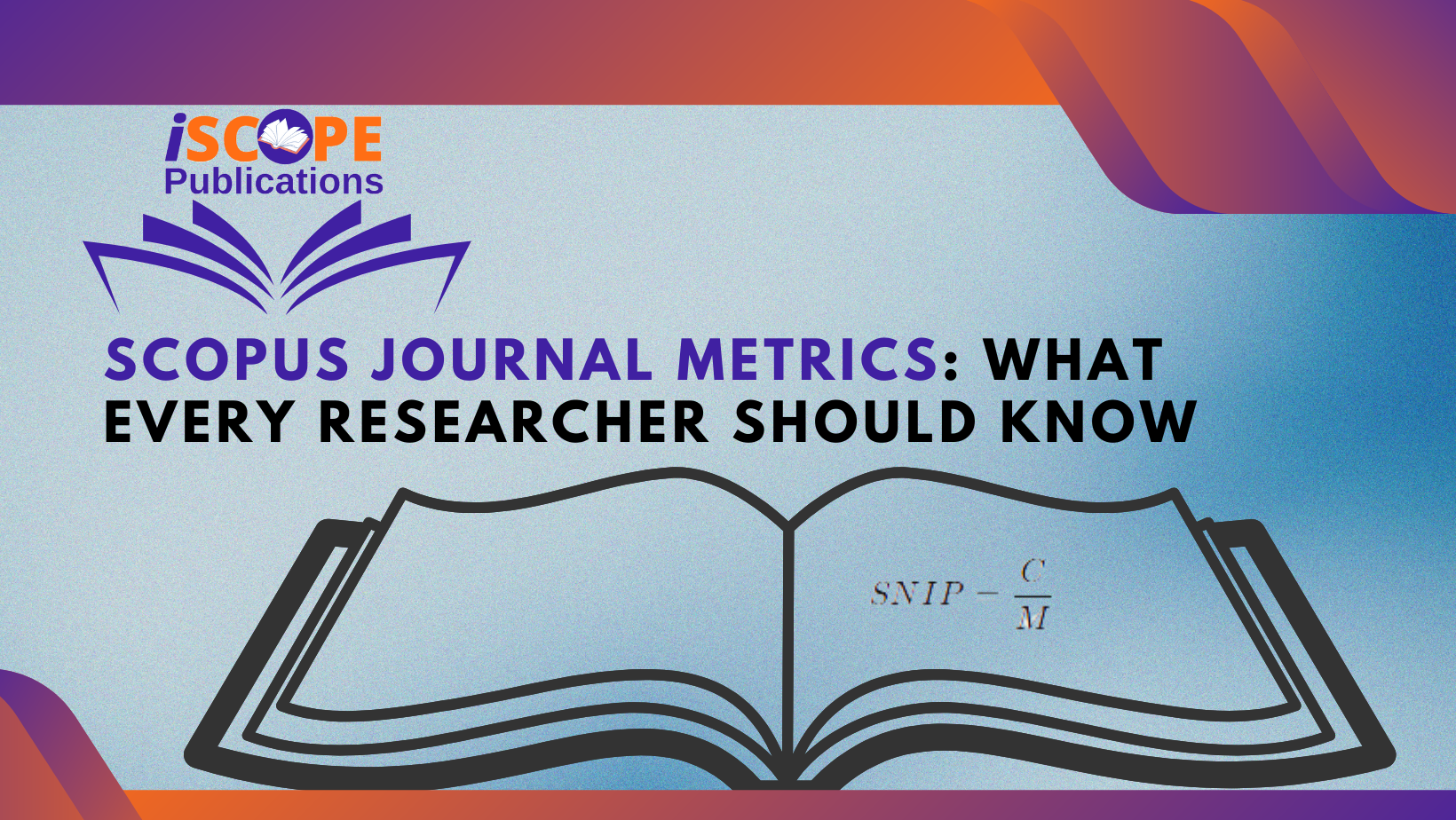Understanding Scopus journal metrics – SNIP, SJR, and Cite Score – is essential for researchers aiming to navigate the complexities of academic publishing. These metrics provide valuable insights into journal quality and research impact, helping researchers make informed decisions about where to publish their work. By leveraging these metrics effectively, researchers can enhance the visibility of their research, target the right journals, and ultimately contribute to the advancement of knowledge in their respective fields. As academic publishing continues to evolve, staying informed about these metrics will be vital for achieving research success in a competitive landscape.

Importance of Journal Metrics
Academic journal metrics serve as vital tools for researchers, institutions, and funding bodies. They help assess:
- Journal Quality: Metrics provide insights into the reputation and influence of a journal within its field.
- Research Impact: They indicate how often articles in a journal are cited, reflecting the research’s reach and significance.
- Publishing Decisions: Researchers often use these metrics to select suitable journals for their submissions, ensuring their work reaches a relevant audience.
Understanding these metrics is essential for making informed decisions about where to publish, how to assess the quality of journals, and how to evaluate the impact of research.
Scopus
Scopus is one of the largest abstract and citation databases of peer-reviewed literature. It covers a wide range of disciplines, making it a vital resource for researchers. Scopus provides several metrics that help evaluate journals:
- Source Normalized Impact per Paper (SNIP)
- SCImago Journal Rank (SJR)
- CiteScore
Each of these metrics offers unique insights into journal performance and research impact.
1. Source Normalized Impact per Paper (SNIP)
What is SNIP?
SNIP measures the contextual citation impact of a journal by considering the citations received by a journal’s articles in a particular field. Unlike traditional impact factors, which might favor journals in disciplines with higher citation rates, SNIP accounts for the differences in citation practices among various fields.
How is SNIP Calculated?
SNIP is calculated using the following formula:
SN IP = C/M
Where:
- C = the number of citations in a given year to documents published in the journal in the previous three years.
- M = the average number of citations received in the same year by all documents published in the same subject area.
This normalization allows for a fair comparison of journals across different fields.
Why is SNIP Important?
- Field Normalization: SNIP accounts for the unique citation patterns of different academic disciplines, offering a more equitable assessment of journal impact.
- Contextual Relevance: Researchers can use SNIP to identify journals that are highly regarded within their specific field, ensuring their work is published in a relevant and respected outlet.
2. SCImago Journal Rank (SJR)
What is SJR?
The SCImago Journal Rank (SJR) metric measures the scientific influence of scholarly journals by considering both the number of citations received and the prestige of the journals that cite them. The SJR metric is designed to capture the quality of the journals from which the citations come.
How is SJR Calculated?
SJR is calculated using the following formula:
SJR = C/P
Where:
- C = the number of citations received in a given year by the articles published in the journal in the previous three years.
- P = the total number of articles published in the journal in those three years, with each citation weighted according to the prestige of the citing journal.
This calculation emphasizes citations from higher-ranked journals, providing a measure of the overall quality of citations.
Why is SJR Important?
- Quality of Citations: SJR gives more weight to citations from journals with higher status, making it a more nuanced measure of influence than simple citation counts.
- Comparative Analysis: Researchers can use SJR to compare journals within a specific field, making it easier to identify reputable journals for publication.
3. CiteScore
What is CiteScore?
CiteScore is a metric that reflects the average number of citations received per document published in a journal over a specific period. It is a straightforward measure of journal performance.
How is CiteScore Calculated?
CiteScore is calculated using the formula:
Cite Score = C/D
Where:
- C = the number of citations received in a year to documents published in the journal in the previous three years.
- D = the total number of documents published in the journal in those same three years.
This metric provides a simple average citation rate per document, making it easy to understand.
Why is CiteScore Important?
- Simplicity: CiteScore’s straightforward calculation makes it easy for researchers to grasp and compare journal performance.
- Broad Coverage: CiteScore includes all types of documents published in the journal, providing a comprehensive view of the journal’s impact.
Comparing SNIP, SJR, and CiteScore
While SNIP, SJR, and CiteScore all aim to measure journal impact, they do so in different ways. Here’s a comparison of their key features:
| Metric | Focus | Calculation Method | Normalization | Type of Output |
|---|---|---|---|---|
| SNIP | Contextual impact | Citations / Average citations in field | Yes | Numeric score |
| SJR | Quality of citations | Citations weighted by source prestige | Yes | Numeric score |
| CiteScore | Average citations | Citations / Total documents | No | Numeric score |
Understanding the Differences
- SNIP is particularly valuable for assessing journals in fields with varying citation behaviors, making it ideal for interdisciplinary research.
- SJR emphasizes the quality of the citing sources, providing a more nuanced perspective on journal influence.
- CiteScore offers a straightforward measure of journal impact based on citation averages, which can be useful for quick assessments.
Practical Implications for Researchers
Understanding these metrics can significantly impact a researcher’s publishing strategy. Here are some practical implications:
Choosing the Right Journal
- Field Relevance: Use SNIP to identify journals that are well-regarded in your specific research area.
- Quality of Influence: Refer to SJR to find journals that not only have high citation counts but also receive citations from prestigious sources.
- Quick Assessments: Utilize CiteScore for a quick understanding of a journal’s citation performance.
Enhancing Visibility and Impact
- Targeting High-Impact Journals: Publishing in journals with high SNIP, SJR, and CiteScore can increase the visibility of your research and attract more citations.
- Understanding Your Audience: Recognizing the metrics that matter in your field can help tailor your research to meet the expectations of journals and their readership.
Navigating the Publishing Process
- Strategic Submissions: By analyzing journal metrics, researchers can strategically submit their work to journals that align with their research impact goals.
- Evaluating Journal Changes: Keeping an eye on fluctuations in these metrics over time can help researchers stay informed about the evolving landscape of academic publishing.
In the ever-evolving world of academic publishing, understanding journal metrics is crucial for researchers aiming to publish their work in reputable journals. Among the various metrics used, Scopus journal metrics – specifically Source Normalized Impact per Paper (SNIP), SCImago Journal Rank (SJR), and CiteScore – play a pivotal role in evaluating journal quality and research impact. Provides a detailed breakdown of these metrics, their methodologies, and their significance in academic publishing.



